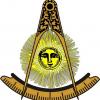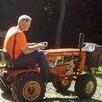By
Sarge
Ok , been asked a lot of questions about how I rebuild front axles - unless they are physically broken no axle is really past the wear point of being rebuildable .
I'm starting with an early D series front axle and upgrading to a later model D series 1" spindle type with the heavier casting . Since I could never find any pics of a comparison - here we go....
If you look closely - there is an obvious difference in the castings at the spindle end - the later model axles were thicker and larger diameter to accept the heavy duty 1" spindles. Later model (post '75 , I believe).
This photo really shows the obvious difference in diameter - early models were much smaller and a thinner casting for the early 3/4" only spindles . Need to find someone with a tape measure and one of the oddball early D-200 1" spindle equipped tractors to find out if those were a thin casting or the thicker type .
The machined relief is for the roller thrust bearings that were originally used - if you ever buy a D or I believe the 520's , this is the first thing to check as many were never properly greased and destroyed that bearing . This can really wreck an expensive spindle and make it more difficult to rebuild the axle casting itself . I will be re-machining these reliefs to mimic the factory design to keep dirt out and retain the grease inside the bearing .
Early castings , at least on this 18 Auto or D-180 that I have (missing the stupid id tag completely) measures roughly 1-1/2" outside ...
Later model upgraded casting is a whole different animal - there are major differences in how they were cast and not just at the spindle ends . Later models were 1-3/4" on the outside .
Since I've never seen a new old stock replacement I'm not certain as to the original finish quality of the machining on these things - it is obvious that over time dirt has entered and a lack of proper grease results in the bores being worn badly - some are literally egg-shaped , especially tractors from the late 60's with high hours and heavy use . Snowblowers and other heavy front implements of course accelerate this wear issue - I'm out to cure that and make the unit more serviceable .
The biggest , #1 problem with these is how they are greased . I've bought and sold tractors for years and had some that had huge grease balls around the spindles , inside the wheels and all over the front end . At least they were trying but the wear is almost no different than one that was seriously neglected . With the weight on the spindle , the grease is forced upward and exits at the E-clip at the top , never lubricating the bottom where it rides on the spindle base for the steering arm .
The correct way to grease these things is to lift the tractor BY THE FRAME , NOT THE AXLE ITSELF . Also , do not lift it by the front mule quick attach - you will bend the cross rod for the latch and destroy it . Best way is to use a block on the frame itself or make a spreader to fit the jack , maybe I can take the time to get pics to show better ways to pick these things up since they aren't exactly lightweight ...lol .
No make or brand was exempt from this issue , they all did it . The problem becomes parts availability - there are only so many parts left and finding good spindles and axles is becoming a serious problem . Some brands aren't too bad (such as the green ones) since they still support most of their older models . Unfortunately for us - Toro has chosen to drop these parts and stock is quite limited . I got really lucky and a parts dealer friend had a pair of NOS 1" D series spindles , one of the last pair to exist to my knowledge . Those are getting blueprinted and angles mapped for later - I may tackle making new ones in both the 3/4" and 1" versions . I believe with a little engineering the earlier models made in the 60's could use a sort of generic spindle since there little difference in the many models - it was mostly down to the axle's angles and width .
My D will be upgraded to heim joints for the steering . Many of the tie rod and drag link ends are NLA and finding steering arms that don't have the tapered holes wallowed out is getting pretty tough . The low angle taper on those automotive style ends allows them to work loose despite having fine thread castle nuts and cotters - the force required to turn the wheels due to the above mentioned lubrication issues , combined with a gear reduction Ross type steering box makes the holes in the arms wear - I've seen 4 of these spindles on different D's all worn the same way with the tapered factory holes oval in shape and the shanks on the rod ends could be easily turned with a wrench, which should not be possible .Converting to heims is not too hard and less expensive in the long run - the only issue being the left hand threaded rod ends at the steering bell crank (or idler arm) . Since it sits so close to the underside of the frame and being tight quarters we may have to resort to using a reduced size heim joint which are easily obtained if you know the part number systems . I have a NOS pair of factory rod ends (ball joints in the parts manual) so this one won't be getting this upgrade for now .
The factory bell crank is subject to wear like everything else . It's buried up under the engine and I suspect most were neglected being so hidden . Inside is a steel bushing riding on the cast iron bore of the bell crank . The retaining bolt , bushing and iron casting all get worn - which results in sloppy steering . On a D that's a real problem since their turning radius is huge to begin with . I've modified mine slightly by moving the turning arc point of the drag link inward by 3/8" - when it's done I'll test and measure the turning radius to see how much it helped and if there is any interference or other issues . Models with working turning brakes in either the stock D-200 or kit-equipped smaller models of course helped when in dirt or grass - just never use those on pavement or hard surfaces since it can really bind things up and possibly cause rear axle damage . It's all mentioned in the manual and instructions for the kits to add turning brakes .
Not sure yet if I'll just make a separate thread on the steering parts or include them here - plenty of info to make a long thread on the cast iron axle alone . Depending upon how well it works out I may offer this as another service to the long list of other parts I build or rebuild currently . Guy with a lathe , far too many tools and a TIG welder must stay busy during the long winters....lol .
So far, it hasn't been a cheap venture - tooling bits and parts totals are well over $400 and climbing - haven't really started any machine work on the axle as of yet since I'm still waiting on one tooling bit . I will try to document what is used in the rebuild and a parts list as well as sources . All bushings and bearings used will be off the shelf parts so it's nothing that isn't easily available . Lathe work my be required to avoid using custom ordered parts and their associated extra costs .
Anyhow , more to follow....
Sarge
Going forward

 By Ralpho711
By Ralpho711 By ebinmaine
By ebinmaine By Sarge
By Sarge By edwalsh18
By edwalsh18